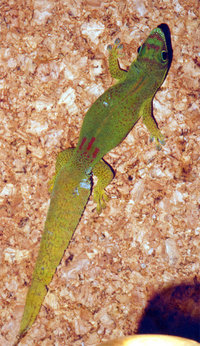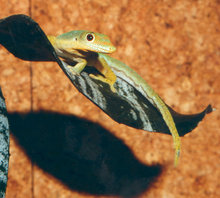Flat-tailed day gecko
|
|
| Flat-tailed day gecko | ||||||||||||||||||
|---|---|---|---|---|---|---|---|---|---|---|---|---|---|---|---|---|---|---|
 | ||||||||||||||||||
| Scientific classification | ||||||||||||||||||
| ||||||||||||||||||
| Binomial name | ||||||||||||||||||
| Phelsuma serraticauda |
| Contents |
Scientific name
- Phelsuma serraticauda MERTENS 1963
Common name
- Flat-tailed day gecko
General introduction
- This diurnal gecko lives in eastern Madagascar. It typically inhabits rainforests and dwells on trees. The Flat-tailed day gecko feeds on insects and nectar.
Description
- This lizard can reach an average total length of about 13 cm whereas females are slightly smaller. Some males may even reach a length of 15 cm. The body colour is dark green or yellowish green. Remarkable is the broad, flattened tail with serrated edges. On the lower back three red tear-shaped markings dots are present. On the neck, which may be bluish, two longitudinal yellow stripes are present. On the snout and head, there are three transversal red bars.
Distribution
- This species occurs on the east coast of Madagascar. It is only known from the region 12 km north of Toamasina.
Habitat
- Phelsuma serraticauda is largely restricted to coconut palms yet can also be found on banana trees.
Diet
- These day geckos feed on various insects and other invertebrates. They also like to lick soft, sweet fruit, pollen and nectar.
Behaviour
- This species lives in groups with one male and up to five females. Amongst the females, there is a well developed dominance hierarchy. Juveniles are tolerated up to a certain size.
Reproduction
- The females lay up to 4 pairs of eggs per year. At a temperature of 28°C, the young will hatch after approximately 53-58 days. The juveniles are typically 40 mm in length.
Care and maintenance in captivity
- These animals should be housed in pairs or small groups and need a large, well planted terrarium. The temperature should be between 25 and 28°C. The humidity should be maintained between 75 and 90%. In captivity, these animals can be fed with crickets, wax moth larvae, fruit flies, mealworms and houseflies.
References
- Henkel, F.-W. and W. Schmidt (1995) Amphibien und Reptilien Madagaskars, der Maskarenen, Seychellen und Komoren. Ulmer Stuttgart. ISBN 3800173239
- McKeown, Sean (1993) The general care and maintenance of day geckos. Advanced Vivarium Systems, Lakeside CA.

